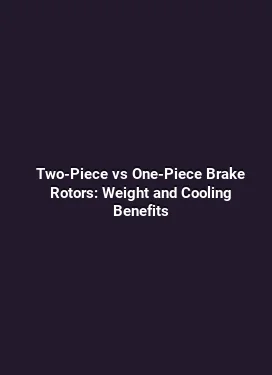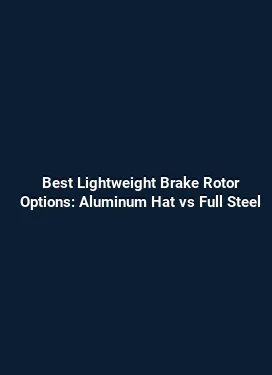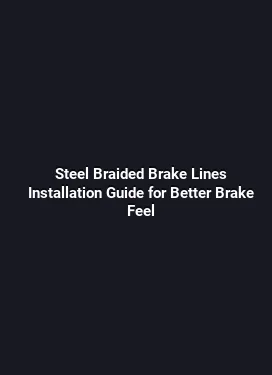StopTech vs Brembo Street Brake Kits: Which Offers Better Value?
Overview of Street Brake Kits

Brake kits designed for street use aim to balance bold stopping power with everyday practicality. When evaluating StopTech and Brembo, the conversation centers on how a kit’s caliper design, rotor construction, pad compounds, and fluid compatibility translate into real-world performance, reliability, and cost over time. StopTech often emphasizes engineered brake balance and thermal management, while Brembo is renowned for its aggressive bite, rotor efficiency, and high-performance pedigree. For daily drivers, enthusiasts who tackle spirited canyon runs, and club racers who stay within street-legal limits, understanding the practical implications of these design choices helps buyers identify where value lies beyond the sticker price.
In street-oriented applications, the ability to maintain pedal feel, resist fade, and deliver consistent braking under varying conditions is paramount. The choice between StopTech and Brembo can hinge on how predictable the initial bite feels, how the calipers manage heat, and how the rotors wear over tens of thousands of miles. It is equally important to consider how readily available replacement components are, how easy the installation is for a shop or a capable hobbyist, and how the kit integrates with existing braking hardware such as ABS sensors and brake lines. This section examines the core attributes that influence value in street brake kits and sets the stage for a more detailed comparison.
Key differences between StopTech and Brembo Street Kits

StopTech street kits often highlight features designed for balanced braking performance across a range of speeds and driving styles. The emphasis is frequently on evenly distributed clamping force, thermal stability, and a system that remains predictable during repeated stops. Brembo, conversely, tends to showcase aggressive response with high initial bite and strong high-temperature performance. This can translate into a more immediate, assertive feel at the pedal, particularly in spirited driving scenarios where quick deceleration is valued. When assessing value, it is essential to consider how these characteristics align with the vehicle’s weight, tire setup, and typical driving environment.
Both brands support a spectrum of rotor types, pad compounds, and hardware configurations. The common ground includes vented rotors to dissipate heat, bonded or iron-core calipers for durability, and brake lines designed to maintain consistent hydraulic pressure. The practical takeaway is that the best value emerges from a kit that matches the vehicle’s needs: daily usability, occasional track exposure, or a blend of both without compromising safety or reliability.
Performance, Durability, and Real-World Value
The value of a brake kit in real-world terms rests on how its components hold up under regular driving and occasional aggressive braking. Durability is linked to rotor material, coating, and the interaction with pad compounds. Caliper design influences how evenly the pad surfaces wear and how quickly the system dissipates heat. In long drives or mixed-use scenarios, users notice how the braking system responds after repeated stops, how quickly the pedal returns to its resting position, and whether there is any perceptible vibration or noise. These qualitative observations combine with quantitative measures such as stopping distance, fade resistance, and rotor wear rate to shape overall value.
From a maintenance perspective, replacement intervals for rotors and pads are a major driver of total ownership cost. Some riders prefer Brembo’s high-performance pad compounds paired with rotors that stay material-stable at elevated temperatures, accepting a potentially shorter rotor life in exchange for stronger initial response. StopTech’s approach is often centered on balance and longevity, which can translate into longer rotor life and steadier performance across a typical driving cycle. The key is to quantify usage patterns: daily commuting with occasional highway braking, or weekend canyon runs with several high-effort stops per session. The more the kit aligns with these patterns, the better its value proposition becomes.
Thermal management and fade resistance in practice
Thermal management is not a single feature but a system-level attribute. Vented rotors with optimized vane geometry and calipers designed for even heat distribution help reduce brake fade. In practice, drivers reporting less pedal fade after repeated hard stops indicate the kit sustains performance better under stress. The choice between StopTech and Brembo can hinge on whether a driver prioritizes consistent feel over the full braking arc or seeks shorter stopping distances with sharper initial response. For street use, neither brand sacrifices reliability, but the preferred emphasis shifts based on how the vehicle is used day to day.
Pad compounds also influence fade characteristics. A compound that works well at moderate temperatures but loses efficiency at high heat can lead to a longer stopping distance as temperatures rise. Conversely, compounds engineered for high-temperature operation maintain consistent friction, delivering predictable behavior. The value comes from selecting a compound that remains stable across the vehicle’s typical climate, traffic patterns, and braking cadence.
Installation, Compatibility, and Aftermarket Support
Installation complexity is a practical factor in perceived value. Street brake kits are designed to be drop-in upgrades with minimal modification, but some vehicles may require additional hardware or calibration. The inclusion of essential mounting hardware, bellows, and high-quality brake lines matters because it reduces additional procurement time and potential compatibility issues. Aftermarket support, including detailed installation guides, technical support, and accessible replacement parts, directly affects long-term value. Shops and enthusiasts benefit from a vendor ecosystem that offers clear compatibility data, torque specifications, and known-good configurations for particular make/model combinations.
Compatibility considerations extend beyond the caliper and rotor themselves. ABS wheel speed sensors, tone rings, and brake fluid compatibility with the vehicle’s system are important for ensuring reliable operation. Brake fluid compatibility, in particular, can influence pedal feel and response, especially on vehicles that frequently experience heat buildup or aggressive braking patterns. When evaluating value, buyers should verify that the kit is designed to integrate with their existing braking system without requiring extensive rework or specialized tools.
Fitment and common installation nuances
Fitment is largely determined by wheel size, suspension geometry, and brake caliper clearance. Some kits demand spacers or minor fender modifications to accommodate larger rotors or calipers. Understanding the exact wheel and rotor dimensions helps prevent last-minute surprises. A well-documented installation path, including torque specs and sensor placements, reduces installation time and minimizes the risk of improper mounting, which can affect performance and safety.
One practical approach is to consult the vehicle’s service manual and the kit manufacturer’s fitment matrix. Cross-referencing with a trusted installer can also reveal potential issues, such as the need for upgraded brake lines to match the hydraulic volume of the new calipers. The end result should be a braking system that feels integrated with the car’s overall dynamics rather than a standalone upgrade that introduces new variables into the braking experience.
Value-Driven Buying Guide: How to Choose the Right Kit
Choosing a brake kit comes down to aligning performance expectations with operating conditions and total cost of ownership. A value-focused buyer starts by defining driving priorities: smooth daily driving, spirited but legal street use, or occasional track days on a street-legal setup. This clarity guides the selection of rotor diameter, caliper size, and pad compound. For example, a larger rotor with a robust pad compound can offer cooler operation and longer life under consistent use, while a lighter rotor setup may appeal to drivers seeking more immediate pedal feel and reduced unsprung weight. Both approaches can deliver strong value when matched to the vehicle’s physics and the driver’s expectations.
Pricing is only one component of value. Installation ease, compatibility, availability of parts, and demonstrated reliability over time all contribute to the total cost of ownership. A kit with strong parts support, straightforward maintenance intervals, and a track-record of consistent performance in various weather conditions often yields better long-term value than a lower upfront price with limited stock or support. For enthusiasts who value repeatability and confidence across a broad driving regime, a balanced kit from either StopTech or Brembo can be a sound investment that enhances safety and confidence on public roads as well as on backroads.
Practical decision-making steps for buyers
Begin with a baseline: assess the current braking performance, how the pedal feel changes with temperature, and the typical driving route. Then, compare candidate kits by rotor size, caliper count, and available pad compounds. Look for evidence of consistent performance across multiple stops, low rotor wear, and predictable calibration with your vehicle’s ABS and stability systems. Finally, evaluate total cost of ownership, including replacement pad and rotor intervals, fluid compatibility, and maintenance requirements. This approach helps you quantify value beyond the initial purchase price and ensures the chosen kit aligns with real-world driving needs.
Practical Examples and Scenario-Based Guidance
Consider a mid-weight sedan used for daily commuting with weekend canyon drives. A StopTech kit emphasizing balanced braking performance may offer a steady pedal feel and reliable fade resistance, providing comfortable, predictable behavior for varied traffic and climate. A Brembo setup with more aggressive bite could appeal to a driver who prioritizes immediate response during spirited drives but may require more vigilant monitoring of rotor temperature and pad wear. Both options can deliver excellent value when matched to user preferences and maintenance discipline, illustrating how the value proposition is driven by use-case alignment rather than sheer performance numbers alone.
Another scenario involves a compact sports car used primarily on public roads with occasional track events. In this case, a kit that maintains stable heat management and consistent performance across repeated stops can prevent performance degradation during a day at the track while still delivering reliable street behavior. The choice between brands becomes a trade-off between initial bite, gradual fade characteristics, and long-term durability, all filtered through the lens of maintenance costs and parts availability. This nuanced approach underscores why informed buyers often benefit from hands-on testing or expert advice before making a final decision.
Maintenance cadence and long-term care
Maintenance frequency is influenced by driving style and climate. In hot climates or frequent stop-and-go traffic, rotor wear may accelerate, and pad compound temperature tolerance becomes more critical. Regular inspections of rotor surface condition, pad depth, and caliper operation help preserve performance and avoid unexpected downtime. Maintaining clean hydraulic lines and ensuring proper brake fluid levels also contributes to consistent pedal feel and responsiveness. A well-maintained system typically yields better value over the life of the vehicle, with fewer surprises and smoother operation across varied driving scenarios.
The Bottom Line: Which Kit Delivers Stronger Value?
Both StopTech and Brembo street brake kits offer compelling value propositions depending on the driver’s needs and usage pattern. If the priority is balanced, predictable braking with strong long-term durability suitable for daily driving and occasional spirited sessions, StopTech’s philosophy often resonates. If the focus is on aggressive initial response and high-performance feel with robust high-temperature capability for occasional track use, Brembo’s approach can be highly appealing. The most valuable choice is the one that aligns with the vehicle’s weight, tire setup, driving habits, and maintenance readiness, ensuring that performance characteristics are sustainable over the vehicle’s lifetime.
Conclusion-Alternative Considerations for Informed Buyers
When evaluating brake kits, it is essential to assess not only the headline performance figures but also how the system behaves under real-world conditions, how easy it is to service, and how well it integrates with existing car dynamics and safety systems. A thoughtful decision considers heat management, pad life, rotor wear, and the availability of replacement parts. A well-chosen kit delivers consistent, controllable braking, confidence on variable roads, and a favorable total cost of ownership over several years of use, making it a prudent investment for drivers who prioritize safety and reliability alongside performance.






